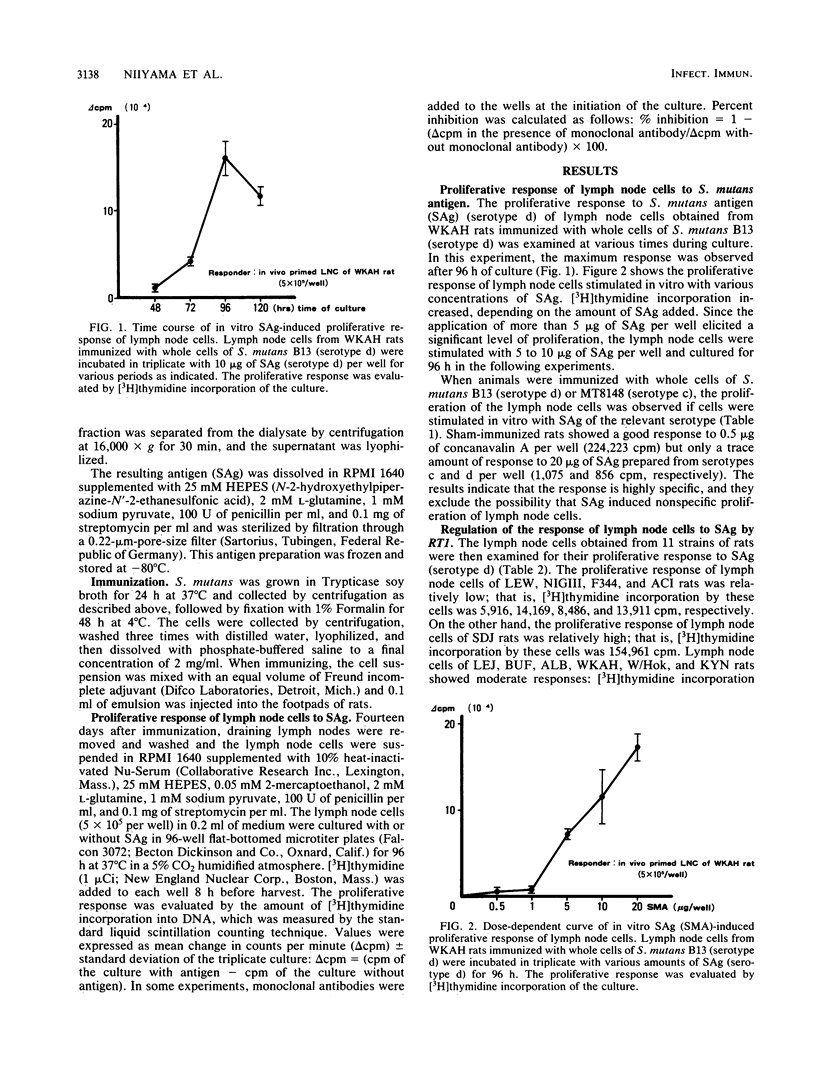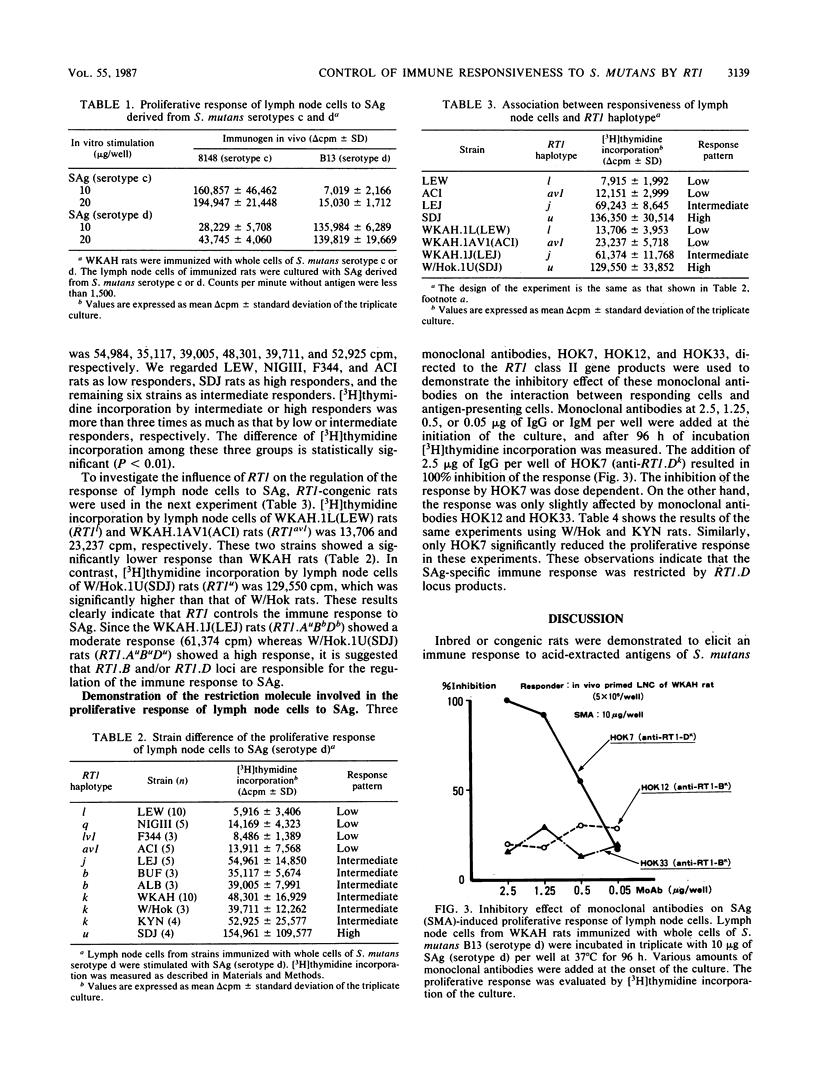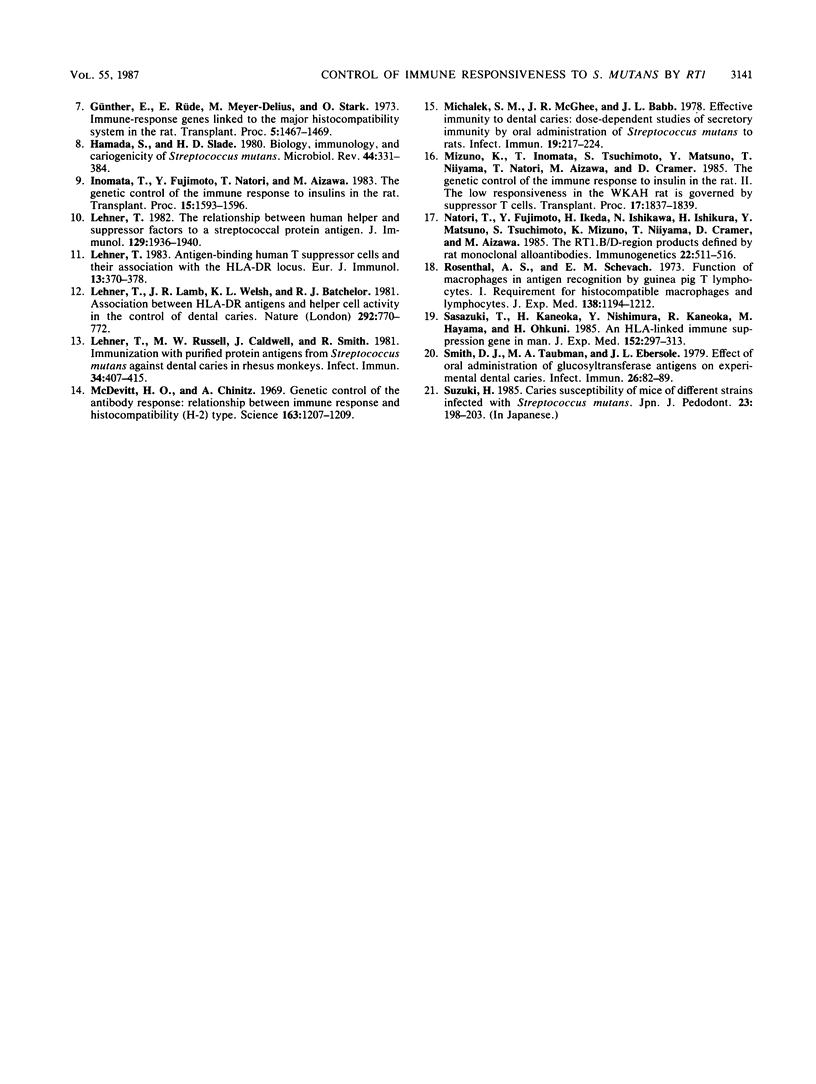Abstract
The lymph node cells from 11 strains of rats, differing in the genotype of the major histocompatibility complex of the rat (RT1), were examined on the basis of their proliferative response to the cell wall antigen of Streptococcus mutans. The 11 rat strains fell into three groups: high, intermediate, and low responders. To demonstrate the influence of the major histocompatibility complex on immune responsiveness to S. mutans, further experiments were performed using the RT1-congenic rat strains WKAH.1L(LEW), WKAH. 1AV1(ACI), and WKAH.1J(LEJ), which differ only in the genotype of the RT1 region. Although the background genes of each strain were of WKAH origin, WKAH.1L(LEW) and WKAH.1AV1(ACI) rats showed a low response whereas WKAH.1J(LEJ) rats showed a moderate response to the S. mutans cell wall antigen. The results indicate that the immune response is controlled by the class II gene(s) in RT1. Furthermore, the RT1.D locus products were shown to play an important role in the restriction molecule, since a monoclonal antibody, HOK7, directed to the RT1.Dk locus products reduced the proliferative response of lymph node cells.
Full text
PDF




Selected References
These references are in PubMed. This may not be the complete list of references from this article.
- Ball E. J., Stastny P. Antigen-specific HLA-restricted human T-cell lines. II. A GAT-specific T-cell line restricted by a determinant carried by an HLA-DQ molecule. Immunogenetics. 1984;20(5):547–564. doi: 10.1007/BF00364357. [DOI] [PubMed] [Google Scholar]
- Chan M. M., Bias W. B., Hsu S. H., Meyers D. A. Genetic control of major histocompatibility complex-linked immune responses to synthetic polypeptides in man: poly(L-phenylalanine, L-glutamic acid)-poly (DL-alanine)--poly(L-lysine) and L-glutamic acid, L-alanine, L-tyrosine (60:30:10). Proc Natl Acad Sci U S A. 1984 Jun;81(11):3521–3525. doi: 10.1073/pnas.81.11.3521. [DOI] [PMC free article] [PubMed] [Google Scholar]
- Ebersole J. L., Taubman M. A., Smith D. J. Effect of neonatal thymectomy on dental caries in rats. Infect Immun. 1982 Dec;38(3):1130–1136. doi: 10.1128/iai.38.3.1130-1136.1982. [DOI] [PMC free article] [PubMed] [Google Scholar]
- Gill T. J., 3rd, Cramer D. V., Kunz H. W., Misra D. N. Structure and function of the major histocompatibility complex of the rat. J Immunogenet. 1983 Aug;10(4):261–273. doi: 10.1111/j.1744-313x.1983.tb00804.x. [DOI] [PubMed] [Google Scholar]
- Günther E., Rüde E., Meyer-Delius M., Stark O. Immune-response genes linked to the major histocompatibility system in the rat. Transplant Proc. 1973 Dec;5(4):1467–1469. [PubMed] [Google Scholar]
- Hamada S., Slade H. D. Biology, immunology, and cariogenicity of Streptococcus mutans. Microbiol Rev. 1980 Jun;44(2):331–384. doi: 10.1128/mr.44.2.331-384.1980. [DOI] [PMC free article] [PubMed] [Google Scholar]
- Lehner T. Antigen-binding human T suppressor cells and their association with the HLA-DR locus. Eur J Immunol. 1983 May;13(5):370–378. doi: 10.1002/eji.1830130505. [DOI] [PubMed] [Google Scholar]
- Lehner T., Lamb J. R., Welsh K. L., Batchelor R. J. Association between HLA-DR antigens and helper cell activity in the control of dental caries. Nature. 1981 Aug 20;292(5825):770–772. doi: 10.1038/292770a0. [DOI] [PubMed] [Google Scholar]
- Lehner T., Russell M. W., Caldwell J., Smith R. Immunization with purified protein antigens from Streptococcus mutans against dental caries in rhesus monkeys. Infect Immun. 1981 Nov;34(2):407–415. doi: 10.1128/iai.34.2.407-415.1981. [DOI] [PMC free article] [PubMed] [Google Scholar]
- Lehner T. The relationship between human helper and suppressor factors to a streptococcal protein antigen. J Immunol. 1982 Nov;129(5):1936–1940. [PubMed] [Google Scholar]
- McDevitt H. O., Chinitz A. Genetic control of the antibody response: relationship between immune response and histocompatibility (H-2) type. Science. 1969 Mar 14;163(3872):1207–1208. doi: 10.1126/science.163.3872.1207. [DOI] [PubMed] [Google Scholar]
- Michalek S. M., McGhee J. R., Babb J. L. Effective immunity to dental caries: dose-dependent studies of secretory immunity by oral administration of Streptococcus mutans to rats. Infect Immun. 1978 Jan;19(1):217–224. doi: 10.1128/iai.19.1.217-224.1978. [DOI] [PMC free article] [PubMed] [Google Scholar]
- Natori T., Fujimoto Y., Ikeda H., Ishikawa N., Ishikura H., Matsuno Y., Tsuchimoto S., Mizuno K., Niiyama T., Cramer D. The RT1.B/D-region products defined by rat monoclonal alloantibodies. Immunogenetics. 1985;22(5):511–516. doi: 10.1007/BF00418096. [DOI] [PubMed] [Google Scholar]
- Rosenthal A. S., Shevach E. M. Function of macrophages in antigen recognition by guinea pig T lymphocytes. I. Requirement for histocompatible macrophages and lymphocytes. J Exp Med. 1973 Nov 1;138(5):1194–1212. doi: 10.1084/jem.138.5.1194. [DOI] [PMC free article] [PubMed] [Google Scholar]
- Smith D. J., Taubman M. A., Ebersole J. L. Effect of oral administration of glucosyltransferase antigens on experimental dental caries. Infect Immun. 1979 Oct;26(1):82–89. doi: 10.1128/iai.26.1.82-89.1979. [DOI] [PMC free article] [PubMed] [Google Scholar]
- Suzuki T. [Caries susceptibility in mice of different strains infected with Streptococcus mutans]. Shoni Shikagaku Zasshi. 1985;23(1):198–203. [PubMed] [Google Scholar]
- de Vries R. R., Zeylemaker P., van Palenstein Helderman W. H., Huis in 't Veld J. H. Lack of association between HLA-DR antigens and dental caries. Tissue Antigens. 1985 Mar;25(3):173–174. doi: 10.1111/j.1399-0039.1985.tb00432.x. [DOI] [PubMed] [Google Scholar]


